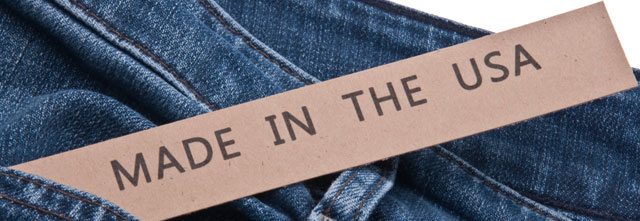One of the major factors in the country’s stubborn unemployment numbers is the loss of manufacturing jobs — 5.6 million in the last decade. All the off-shoring paired with the still-tenuous economy has given momentum to U.S.A.-made product, including apparel.
Government figures show the textile and apparel industries in particular lost more than a million manufacturing jobs in the last decade. More than a quarter-million positions went to China alone, according to the Economic Policy Institute.
Congresswoman Jackie Speier, D-CA, says for America to continue to be strong, the country has to invest in it. She’s been active in supporting Make It In America (MIIA) legislation, and has hosted an MIIA exhibit for two years at her district’s county fair.
“There’s no question Corporate America has the right to manufacture wherever it wants,” Speier says. “We’re just trying to create incentives and value to manufacturers here in the U.S.,” she says in describing the MIIA legislation. “But I think as salaries in China increase, and demands for work safety and transportation costs increase there, many apparel manufacturers will realize there’s a value to making their product in the U.S.”
More than half of all consumers (55%) say it is “very or somewhat important” that the apparel they buy is made in the U.S., according to the Cotton Incorporated Lifestyle Monitor™ Survey. Consumers age 35-to-70 are significantly more likely to feel that way (66% versus 40%).
Erica Wolf, executive director of Save The Garment Center (STGC), a trade association devoted to promoting New York City’s Garment District, says a major step in fulfilling this consumer preference depends on the corporate mindset.
“It has to be a concerted effort by a company,” she says. “You have to want to change your business model. You have to see the value of producing something locally and what that does for your community.”
That is where the MIIA legislation could help. Among other things, it expands lending and offers tax incentives to small businesses; preventing the outsourcing of U.S. jobs by closing tax loopholes for companies that send jobs overseas.
“I hope there’s something behind it,” says Warren Brand, co-owner of M&S Schmalberg, a custom fabric flower manufacturer in New York’s Garment Center since 1919. “We’ve been doing this a long time and it’s really hard now. There are girls here that are not working or leaving early because we don’t have the work. We’re paying bills, taxes and hiring union employees. I hope the government changes things, or styles change or something brings us back to where we need to be.”
Today, just 3% of apparel in U.S. stores is made in the country, according to the Cotton Incorporated Retail MonitorTM survey. In 1960, American manufacturers produced 95% of all apparel sold here, according to STGC.
Roger Cohen is CEO of Regal Originals, a specialty trim stitching company and Scrub/ink, a hospital scrubs manufacturer. At one time, the company, which Cohen’s father-in-law began Regal in 1950, took up two full floors. Today, it takes up only half a floor in the Garment District.
“Save The Garment Center is building awareness about the consequences of not purchasing products made in America and not supporting American workers. In industries like ours, we employ minority groups, and these groups are now hit with tremendously high unemployment — up to 20% percent in some areas. So in this economy, this legislation can only help.”
[quote]
Cohen suggests a campaign demanding manufacturers bring production back to the U.S. “You don’t have to bring back 100% today. But bring back 5% this year and five years from now bring back another 15%, and slowly build up the economy with manufacturing.”
Regal’s Kenny Marvin, salesman, says the industry suffers from the mindset that it’s too expensive or there aren’t the facilities to produce apparel in the U.S.
“Anything that can be made overseas can be made here. And you have control. If something is going wrong in the cutting room, a domestic production manager can make a decision to cut it or not. If it’s in China, and someone isn’t really watching it, they’re going to cut and sew it — and you’re going to own it. Business is suffering because of the economy, but also because of some of the product in stores.”
Six out of 10 shoppers agree U.S.-made apparel is higher in quality than clothes imported from other countries, according to the Monitor. And among those who say it is important to buy U.S.-made apparel, 87% say it is because they prefer to support the U.S. economy.
Braden Kelley, author of Stoking Your Innovation Bonfire and pull marketing strategist, says the tenuous economy has definitely fueled Made in the U.S.A. momentum.
“We’ve been inundated by goods made in other places long enough to learn that sometimes paying a little bit more for something made in America can actually save us money, help the environment and our fellow American at the same time.”
Speier cites the economic stat that says if everybody spent $64 on U.S.-made product, 200,000 jobs would be generated.
“I, for one, am going out of my way to buy American-made garments,” Speier says. “And it isn’t easy to find them. But if consumers demand them, it means jobs. That boosts the economy and raises all of us.”
